Marc MacYoung?
Dianna Gordon MacYoung?
Animal E-list
Crime Avoidance Lectures
Crime Blog
Colorado Classes
Contact Us
FAQs
Hosting A Seminar
Crime Prevention
Expert Witness
Knife Defense
Law Enforcement
Martial Arts
Military
Movie Consulting
Women's Self-Defense
Links
Our Linking Policy
On-line Store
Train with MacYoung
Testimonials
Terms of Use
Topics
of Interest
When you talk about "karate" are you talking about Evaluating a MA style
On this page:
the 97% that doesn't work and will get you mauled
in a self-defense situation? Or are you talking about
the 3% that will break someone in half like a twig?
MM
It's not the style |
Explaining the chapter quote
As a former streetfighter I look at martial arts training differently than most people. When someone executes a move, there is a part of my brain that is calculating how I could hurt them. I'm looking for the holes in what the person is doing that I can attack through. Phrasing this differently I'm not looking at the strengths of the move, I'm looking for the weaknesses.
I spit a whole lot of blood discovering this truth about fighting: It isn't about what you can do to him that matters, it's what he can do to you -- and what YOU can do to prevent that. And this is where most so-called martial arts instruction falls down.
When someone demonstrates a move that might block one hit, but in the process leaves them wide open to four others, I try to point out how they can fix it. Where I get cranky however, is when certain individuals who have bought into ineffective systems first insist that their flawed version would work, but then get downright obnoxious about it. This despite the fact that they are wide open to all kinds of attack. But in their minds that isn't going to happen because they are so effective at attacking using their style. Unfortunately the only way to demonstrate this isn't the case is to physically assault them. Most are neither willing to fight or step into a full contact situation to be proven wrong. So their false assumptions are never revealed as such. Below is a demonstration one such example. It is how a middle knife hand block was taught in a commercial school's kata. To begin with this school didn't allow head contact in their sparring and left several tournament circuits because in open tournaments "other" schools hit too hard. YET the people in that school sincerely believed executing the technique this way would work to keep them safe against an attack.
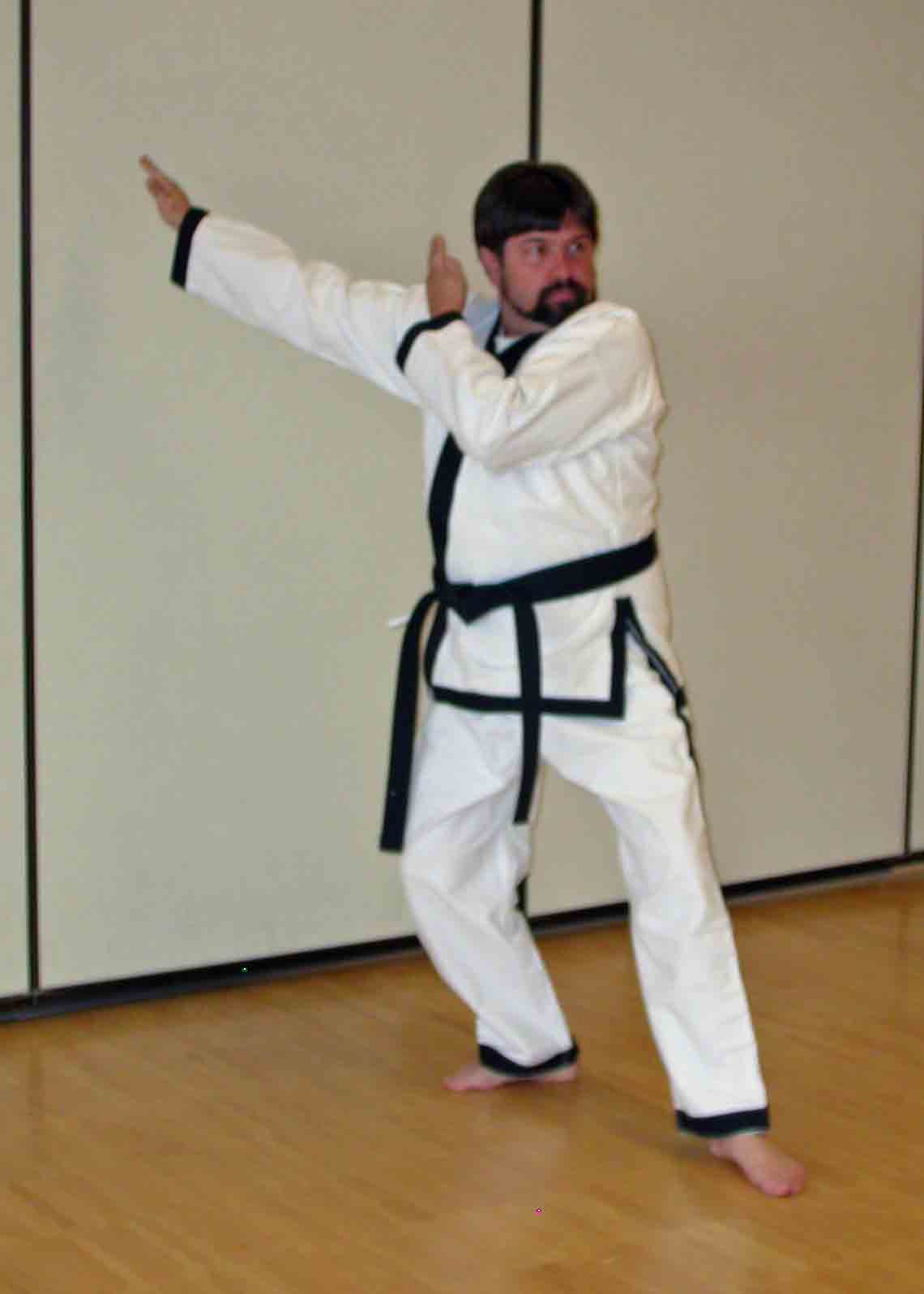
 A
common criticism of the martial arts is that they won't work against a boxer.
Well in light of this example of a so-called "block," there is a lot of validity
in that criticism.
A
common criticism of the martial arts is that they won't work against a boxer.
Well in light of this example of a so-called "block," there is a lot of validity
in that criticism.
Imagine you are a person who can throw three punches in two seconds, and then ask yourself where'd you hit someone trying to block this way. As he moves into the first position and then into the second. The "preparatory" movement leaves individual wide open to multiple face and body shots from the front until the left hand gets back into a defensive position. And even then, you are left wide open to a left handed attack from your opponent because you haven't moved off line.
Here is where things proceed to get really strange. The explanation for this stick your hands way out yonder movement before you blocked was that you were blocking an attack from a second person behind you. This whiz bang move was presented as you were fighting two people at once. This explanation falls down when you realize that the second person either magically disappears or politely stands there while you launch a flurry of attacks on his friend. Or perhaps you knocked him unconscious with your mighty karate backhand. But this begs the question of if you knocked the second guy out with a backhand, then why did the guy in front of you require multiple kicks and punches that followed in the kata?
I'm sure that individuals from effective systems are appalled at this explanation. And I am also certain that individuals who are from equally flawed systems are snickering at the foolishness of the students of that school. "How can they be stupid enough to believe that nonsense? Don't they know that move is for (fill in the blank)?" Unfortunately, often these other explanations are just as unrealistic, ineffective and rigid in interpretation as the example provided here.
But seriously ask yourself: Why shouldn't these students believe this explanation? Most have never been in a fight in their lives. Those that have fought, usually were back in high school. Most have no previous martial arts experience. And a majority chose that particular school as much because of convenience of location as style. Nor are the students encouraged to question what they are told. Another discouraged behavior is to look outside the system. In fact, it is not unusual for someone to be subtly dissuaded from training with other instructors of the same system -- that is unless your instructor invites that instructor to your school. In the business of martial arts keeping students is a major concern and a big part of achieving this is controlling the information students receive. Furthermore, students are commonly told that this is a complete system that works. So they don't need to go shopping elsewhere. In other words, how are students supposed to know what they are learning isn't even in the same state as reality?
But let's get back to that flawed technique. There are several reasons this extra motion was put in. But to understand that, you must first realize what was lost. Realize that the original version worked very well. That's because the original move had important components that made it effective. However, the those components, their application and understanding (bunkai) were lost along the way. Somewhere, some time, someone who had "learned" the move didn't understand the purpose of those component parts. Perhaps they were never explained, perhaps the individual learned the complete move, but left before the bunkai was explained or perhaps an Asian instructor intentionally didn't teach the move correctly to an occidental student. Any and all of these are possible ways to lose these components. But some where along the line the component parts were lost and yet the idea that this is "real" karate remained.
So too did the general form of the kata. But it is here that an important paradigm shift occurred. As the component parts were lost, both the emphasis and the interpretation shifted. For example instead of the moves in the first photo having tactical application, they became preparatory. You were winding up in order to block. But more importantly, the technique "became" the second photo. That is to say that the focus shifted to achieving the end pose. How you got there and what you could do with that movement (bunkai) was functionally ignored. And these problems compound over time.
However, there is method to this madness. Putting your hands way back there makes no sense until you realize it is winding up to increase speed and power. Another important consideration is that it made for a much more dramatic display in tournaments. It is much easier to create crisp and flashy movement from a stationary stance and only using your arms. And the bigger the move the easier it is for judges to see. Furthermore, to do it faster, the move was pared down even more. The wind up position was achieved by moving in a crisp straight line fashion that did nothing to protect the person doing it.
Yet this drastically altered move was still promoted as effective for fighting. That is where the extra speed generated from the wind up really came into play. These kind of extraneous movement patterns are commonly when you attempt to fix a flawed block by turning it into a hit. Can a core movement be used in an offensive manner? Yes. Except that is not what most people are doing when they try to 'hit with their blocks.' Remember we mentioned the focus has shifted away from the process and has become fixated at the end pose? People believe that the second photo IS the block. And they are trying to hit the incoming attack with it. This is utter nonsense.
But this is the kind of erroneous thinking that develops when you think of the end pose as "the move." The technique is the process, not the end pose. But if you think of the end movement as where the technique manifests its power you will lose all the component parts that make for effective movement. What we are saying is that the process should be working for you from the beginning. You should not be waiting for effectiveness to manifest, it needs to be there all along. Using the technique in the photo, the prep time should have been as much of a block as the end position. The person doing the technique should have been defensively covered from beginning to end, not just at the end.
Yet this school was trying to make their blocks work through speed and impact, instead of focusing on having the components that make for effective defense. The problem with this idea was that in attempting to get extra speed, they were actually leaving themselves open to attack for a longer period of time. They were wasting valuable time, by going way out there with their wind up. Time that no matter how fast they came back was still lost. And that is time that you cannot afford to lose. A jab, jab, cross combo would make mincemeat out of them.
In losing these components, the effectiveness of the move began to suffer. However, the pretense that the move was still effective remained. This creates a bit of a dilemma. It was supposed to work, but there were problems of it not working -- at least among the students. (Although it is interesting to note that despite his claims that it worked, the head instructor, seldom -- if ever -- used this block in his own sparring). Seeking to fix the move's failures lead to a gradual changes in how the move was executed. Extra moves were added to patch holes in how the school was doing the block. The problem was that the fixes often created even more problems In discussing this move with several students who had been at the school for upwards of 15 years, the move had been changed several times. Incidentally, even though the school still remains fixated on the end pose, they have returned to an earlier preparatory position, that while it still leaves them vulnerable, is a little less so. And the head instructor did it without batting an eye over the constant changes in the system he implemented -- up to and including leaving teaching Tae Kwon Do and claiming what he was doing was it's own martial art style.
There were multiple instructors in this chain of schools. They all taught the move this way in the kata. They also claimed that kata taught you how to fight, but, like the head instructor, they didn't use kata moves in their sparring. You never saw this block done in the sparring ring because people knew they'd get hit if they tried it. This brings us to another interesting point. They had entirely different body movement patterns and strategies in the sparring ring. They didn't use their kata at all in the ring. They also had totally different moves for what they called "self-defense." And yet they claimed it was all the same martial art!
We're not talking different aspects or applications here. We are talking about three completely different systems of movement being presented as the same martial art system. In fact, there was open discussion about the idea that you had to train for each aspect separately. You didn't use your kata for self-defense and yet they constantly told themselves that it would work.
Stop and think about this for a moment, because when you do there is a serious "Huh?" question that comes to mind. That is: If what they are doing is so effective, then why the differences?
Why do you need three different systems of movement? Why aren't they using the same thing in all three situations? If it works, then it works. So with that in mind ask yourself how often do you use movement out of your kata in the ring? If what you are being taught in kata really is effective you should have no problem using it all the time! If you aren't then there is something wrong.
So with this in mind, one must ask oneself how can you tell an effective martial art system from an ineffective one? And this especially in light of all the nonsense that is being promoted AS martial arts.
We're going to give you some pointers.
It's not the style
I'm going to explain the "why" of this statement from a slightly different
direction than you'll expect. The first time I went to Europe in the 1990s I
noticed something about Europeans that was drastically different from Americans.
In the United States people not only served as walking billboards for
mega-corporations, but they paid for the right to advertise for these
corporations by displaying the brand name/logo on their clothing. They actually
went out and paid for clothing that advertised the brand. Fashion and status
were as much about showing something that identified the product as how you
looked. This trend goes back to "Members Only" jackets of the 80s, and continues
on today with companies like Nike, Tommy Hilfiger, Big Dog and into professional
sports (those franchises get a percentage of every item sold with their logo).
The everyday impact of marketing on how Americans think is so
ingrained that people didn't even notice it anymore, they just accept the basic
premise.
Back when I first landed in Europe, I immediately noticed something. The Europeans tended to wear plain clothing without identifying tags. The Europeans were not paying for the right to advertise for a company on their clothing. In fact, you could often spot other Americans because of the logos on their clothing. This has changed somewhat. Last time I was in Europe I saw much more product based clothing on the locals. That means marketing was slowly changing the way Europeans think and they are buying into the concept.
But until I had stood on another continent I never realized how ingrained it is in the consumer psyche to think along the lines of brands, advertising and marketing. Nor do we realize how much companies use us to advertise for them. We simply accept the concept without realizing what it has done to how we look at the world. A manipulative and profiteering marketing strategy based on brand names has become background to us. Until you consciously go out and look for it, you won't realize the influence on marketing.
What consumers don't know however, are the realities of manufacturing -- where often the same factories are producing different name brands of the same product. What's more, the same ingredients are going into the higher priced products as the discount brands. Yet we have been so indoctrinated into thinking in terms of brand names that we don't realize this. The same thing has happened in the martial arts, people do not realize how much of what is taught as a particular martial arts is not only influenced by market trends and fad, but isn't what the instructor claims it is. A lot of schools have become like those factories, what they are producing is different in name only.
With this in mind realize the MA/SD/RBSD world is filled with promises to teach you the ultimate fighting system, internet groups of claiming things like silat is better than karate vs. the other side claiming karate is better than silat, mixed martial art competitions, full page ads of studly men glowering at you offering to make you into a stud too, modern combatives, ancient combatives and obscure, esoteric martial arts from exotic -- and mostly distant -- lands. You can't pick up a martial art magazine or walk into a school without seeing all kinds of clothing and gear items that promote either the manufacturer, the school or the style.
With this constant barrage it can be rather difficult to realize when you ask "which martial art style is best?" you are thinking in terms of brand name.
Unfortunately, people have been conditioned to think in these terms. Furthermore, they think that by picking the "right" style they will be taught everything they need to know. This simply isn't true.
And not to put too fine of a point on it, but brand popularity really isn't based on how good the product is nearly as much as how good the advertising for it is. The same goes with martial arts. You've heard the brand name (style) promoted as what is important for so long, odds are you're thinking in those terms.
What we really want you to realize is how much styles these days rely on you advertising for them. You can buy all kinds of clothing and equipment with a schools/style's name on it or catchy motivational/threatening slogans that declare your affiliation with the same. You can go onto internet forums and listen to people extol the virtues of what ever style they practice, how great and grand their instructor is and how you can learn everything you need if you just buy into a particular brand of martial arts. You walk into a supermarket and there is a child, still wearing his belt and uniform with the school logo on the back trailing behind his mother.
That's advertising.
"This style has these great qualities those other styles lack." Have you ever heard this kind of thing? If you replace the name of the style with brand names of laundry detergent you will realize that's the basis of a TV commercial. That's how ingrained thinking in brand names has become.
So here is our anti-brand name version: It doesn't matter what style it is...what matters is that the component parts that make it effective are still there.
In a market where people are running around claiming that their style is better or that martial arts from a particular nation are superior to those of another country, we have to say that we've met practictioners from all kinds of different arts that would wreck total havoc on anyone who crossed them. And we've met high poobah grand masters who couldn't fight their way out of a wet kleenex. On the other hand, we've also met individuals who were the North East Podunk representative of an internationally franchised style. Yet these individuals share whatever one-Starbucks-town they are in with three other "representatives." And you can bet that these guys are all wearing -- and selling -- clothing that promotes that style. Are they competent fighters? Some are, some are incompetent, most are just mediorce, but they have the brand name martial art style.
What we are saying here is you can find schools that teach very effective martial arts and schools that teach absolute crap. And they both will be calling what they do the same style.
This is why you can't trust brand names when it comes to choosing a martial art. There is no style that is automatically superior to another. Nor does it matter what country they are from, when performed effectively they can ALL hurt you. You can even have effective versions and bad versions of the same style. What is far more important than the style is the depth of understanding of the teacher has about what makes what he is teaching you work.
Explaining the chapter quote
The nature of this Website brings us in contact with fanatics of many different
stripes. These individuals are convinced that their particular take on a subject
is correct and everyone else is wrong. In answer to these people we have a
saying "Just because your particular approach to life takes up all your time,
doesn't mean that is all there is to life"
This is for example why I am not impressed with mixed martial arts when they are presented as self-defense. Are they great and exciting sporting events? Yes. Are they what you need to survive a self-defense situation? Not any number of the ones that I've been in, but that's because I come from a place where empty handed fighting was reserved for beating women, punks and for people you didn't want to hurt. If you felt someone was enough of a danger, you reached for a weapon. I don't care how hard someone can hit if he's trying to do it with a sucking chest wound.
However, having said that, empty handed conflict resolution was a huge part of my professional life. You couldn't shoot or stab a drunk you needed to get out of the bar. And any number of quarrels are resolved in civilized circles without anyone dying -- even if they do escalate into physical conflict. Therefore since I was trying to move in those circles it behooved me to be proficient at empty handed control and defensive tactics.
In that process I had some amazing instructors. In essence I break down my teachers into two basic categories. The first were the Been There and Survived That veterans. These people had not only survived combat and other forms of intense violence, but were still actively dealing with danger. They taught me not only 'things that can't be learned in books,' but also the knowledge, awareness and spirit it takes to succeed in the toxic environment of human violence. The thing was, while these guys could resolve a violent situation with incredible efficiency, from a physical control/martial art standpoint, they were 'technically speaking' not that good.
On the other hand, I had martial arts instructors who were not fighters. They were martial artists. And their technical expertise was astounding. These people had physical movement and dynamics that were astoundingly effective, but they hadn't field tested them. They were doing the moves as they had been taught, and what they had been taught hadn't been watered down.
I took both of these teachings with me into many a violent situation. The street cunning, savagery and determination of the vets and the technical skill and focus of artists. And I not only survived, but I thrived using both of their teachings equally.
It was coming out of the streets in the late 80's that I was appalled to see the beginning of both the commercialization and watering down of the martial arts. And at the same time they claimed what they taught would work in a 'real fight.'
"Helllooooooo! What you're doing might work to beat up an accountant, but if you try that ineffective sports based stuff on the bad boys I've been slamming and jamming against all this time, they'll cut your heart out!"
And yet over the years, the more watered down the martial arts became and the more the standards dropped to keep paying students, the more these people insisted what they were doing 'would work."
Back then I didn't know what the move was supposed to look like, but I knew what I was seeing wouldn't work. Therefore in my early writings I was very disparaging about traditional martial arts -- especially Karate.
And then I saw what karate looks like when it isn't watered down, gutted for insurance purposes and pimped for winning tournaments.
I stood up in a crowded room, pointed towards Tristan Sutrisno as he did his kata and loudly declared:
THAT WOULD WORK!!!!
As an ex streetfighter, I instinctively look for ways that I could slip through someone's defenses. I seek out weaknesses I can exploit. Mistakes I can force open into vulnerabilities. There weren't any. I simply could not take this man in a hand to hand conflict. And I knew I was, for the first time in my life, seeing what Karate is supposed to be ... rather than what it had degenerated into.
These days I often joke that in that 3 minute demonstration I was made to eat raw, every bad word I have ever said about Karate.
The truth is, however, those 3 minutes proved me right.
I say this because of 30 years of seeing a shell presented as karate, I was finally seeing what it looked like when everything that was supposed to be there was there. I liken the difference to all my life having seen a car without an engine, a transmission and tires ... and yet people claiming that it was a high performance car. Not knowing anything about auto mechanics I couldn't see what was missing. Then came the day when I finally saw, not just a functional car, but a high performance car in action.
And it was a stunning revelation.
Since that time I have had the absolute joy to meet and watch several other individuals who are equally amazing in their own right. They too have arts that have not been decayed and their art would work in live-fire application. Their names? Sensei Lee Gray. Sensei Sam Walker. Sensei Iain Abernathy. Peter Consterdine. These are men who's arts have not been watered down. Add to that list, any number of people whose works I respect because they too can make their karate stand up and bark (for example Lawrence Kane and Loren Christensen)
However, here's something that those men share with every watered-down, pimped out karate system that I ever encountered in the 30 years I spent dealing with martial artists before I met them and the 10 since. That is: EVERY ONE OF THOSE PEOPLE SWEARS WHAT THEY ARE DOING IS REAL KARATE.
Let me run this by you again ... it's that important. A black belt from the most watered down, money making McDojo (that will guarantee you a black belt in a year) is as utterly convinced as the people I have just listed that HE (or she) IS a real martial artist practicing 'real' karate.
This is why, instead of getting into the bickering and arguing that so infests the martial arts about who is doing 'real' martial arts, who is doing 'good' (fill in the blank' and why that school down the road has it all wrong, when someone starts talking about karate for self-defense, I ask
When you talk about "karate" are you talking
about the 97% that is garbage and won't work?
Or are you talking about the 3% that
will break someone in half like a twig?



Martial Arts America
Learn More >
Order Now!
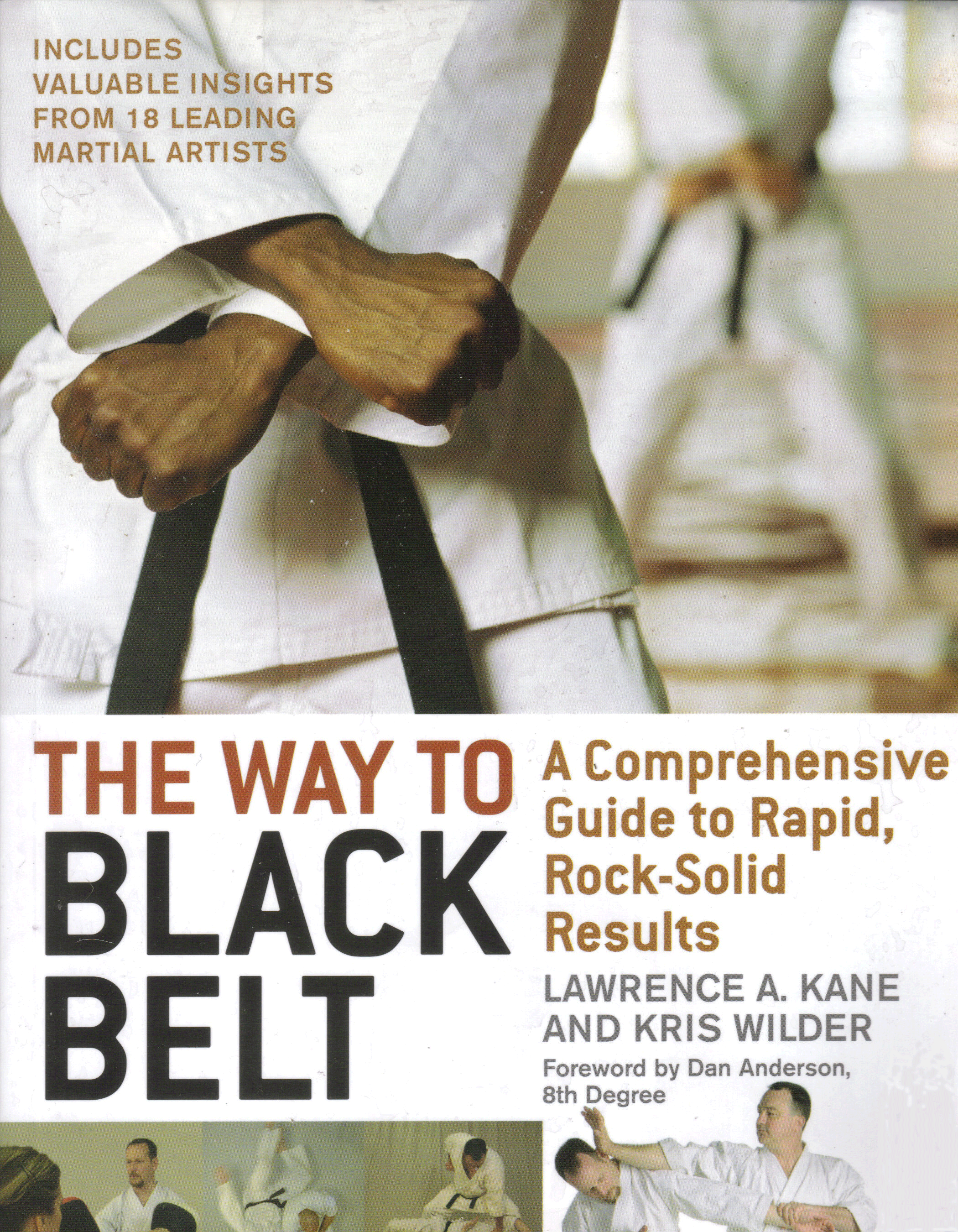
Way To Black Belt
Learn More >
Order Now!

Martial Arts Instruction
Learn More >
Order Now!

The Way of Kata
Learn More >
Order Now!

Fighting Footwork of Kuntao/Silat
Volume 2
Learn More >
Order Now!
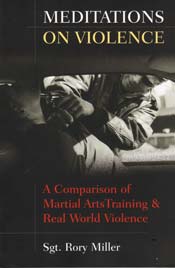
Meditations on Violence
Learn More >
Order Now!

Pukulan Pentjak Silat
Learn More >
Order Now!
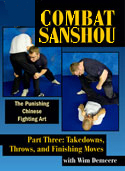
Combat Sanshou:
Takedowns/Throws
Learn More >
Order Now!

Beyond Brazilian Jujitsu
Learn More >
Order Now!

Ground Combatives for Police
Learn More >
Order Now!

Escape Combatives
Special Bonus Feature
ESCAPE DRIVING
Learn More >
Order Now!

Taking It to the Streets
Learn More >
Order Now!

Championship Streetfighting
Learn More >
Order Now!

Fighter's Guide to Heavy Bag
Training (DVD)
Learn More >
Order Now!

Fighter's Guide to Heavy Bag
Training (Book)
Learn More >
Order Now!

Indonesian Fighting
Fundamentals
Learn More>
Order Now!
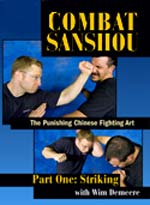
Combat Sanshou: Striking
Learn More >
Order Now!

Fighting Footwork of Kuntao/Silat
Volume 1
Learn More >
Order Now!

Speed Training
Learn More >
Order Now!
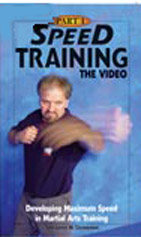
Speed Training: The
DVD
Learn More >
Order Now!

Fists, Wits And A
Wicked Right
Learn More >
Order Now!

Warriors: On Living with
Courage, Discipline and Honor
Learn More >
Order Now!

Filipino Kuntao
Learn More >
Order Now!

Floor Fighting
Learn More >
Order Now!

The Missing Link:
Self-Protection Through Awareness, Avoidance and
De-Escalation
Learn More >
Order Now!
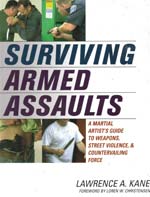
Surviving Armed
Assaults
Learn More >
Order Now!

TACSAFE
Learn More >
Order Now!

Fighting Dirty
Learn More >
Order Now!
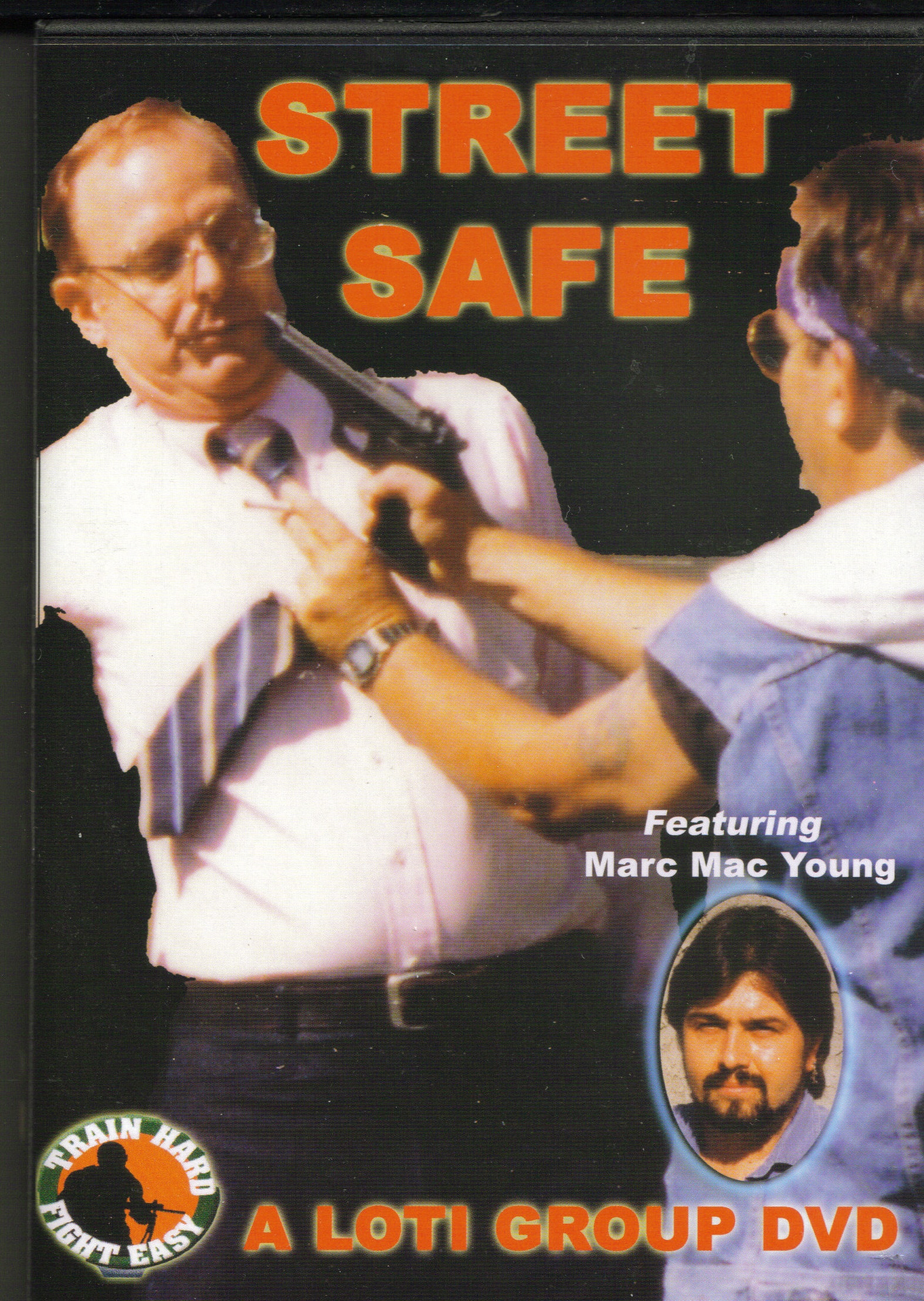
Street Safe: How to
Recognize and Avoid Violent Crime
Learn More >
Order Now!

The Deadliest Men
Learn More >
Order Now!

Violence, Blunders And
Fractured Jaws: Advanced Awareness, Avoidance and Street
Etiquette
Learn More >
Order Now!
| About navigating this site | Animal List | Bibliography | Bullies | Burglary while on vacation | Classes in Colorado | Car Jacking | Children and Martial Arts | Child Safety | Criminal Mindset | Cults in MA/SD | De-Escalation | E-mail Dianna | E-mail Marc| FAQs | Have MacYoung speak about crime avoidance | Home Page | Home Defense | Hosting a Seminar | Fear | Five Stages of Crime | Knife Fighting | Legal Issues | LEO/Correctional Officer/EMS | Linking policy | Links | Martial Arts | Photo Gallery | Property Crime | Psychology | Rape | Robbery | Safe Dating | Self-Defense Training | Selling your books/DVDs on NNSD | Seminar Schedule | Stalking/Domestic Violence | Street Fighting | Terms of Use | Testimonials | Train with Marc MacYoung | Who is Dianna Gordon MacYoung? | Who is Marc "Animal" MacYoung? | Victimhood | Workplace Problems | Zero Tolerance | ||
| ? 1998-2008 No Nonsense Self-Defense, LLC. All rights reserved. |